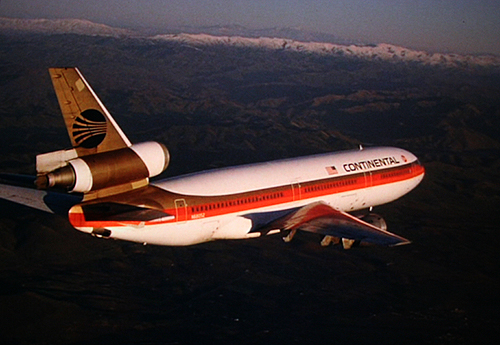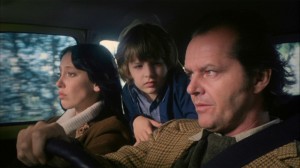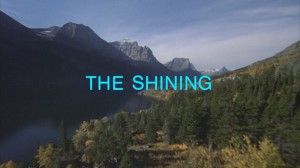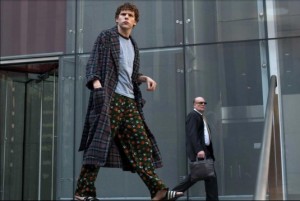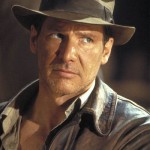The Shining part 6: 8am
For 30 years, the act structure of The Shining has eluded me — there are no clear, classic act breaks, there is no classic end-of-Act-II-low-point, there are no irreversible climaxes in obvious places, etc. This seeming lack of structure all stems from Kubrick’s choice of giving the movie an invisible protagonist: it’s hard to tell how the protagonist’s journey is going if you can’t see the protagonist.
The Shining part 4: A Month Later, Tuesday, Thursday, Saturday
A MONTH LATER
The Torrances have moved into the Overlook. A month has gone by without anyone getting murdered.
Things seem to be going okay, all things considered. Wendy, who seems to enjoy being a wife and mother, acts like she’s playing house in an enormous home. Like Halloran says, “It’s still ain’t nothing but a kitchen.” Yes, you make your breakfast in the kitchen, then you wheel it on a cart past the Gold Room, into the hotel lobby, through God knows where, into an elevator, down the hall, up the stairs and into your bedroom — just like at home!
The Shining part 3: Closing Day
At the beginning of The Shining‘s second section, “Closing Day,” it’s almost like the movie begins again: here are more overhead shots of the yellow VW winding its way up an isolated mountain road. What’s different? Well, this time the car is going around the right side of the mountain instead of the left side.
Much has been written, some of it quite intelligent, about the spatial anomalies and inconsistencies in The Shining: there are rooms with windows that should not be there and doors that couldn’t possibly lead to anywhere, rooms appear to be in one place in one scene and another place in another, wall fixtures and furniture pieces appear and disappear from scene to scene, props move from one room to another, and the layout of the Overlook makes no physical sense. To name only obvious example, the establishing shots of the hotel, which is a real hotel in Oregon, show no gigantic hedge maze off to one side. For myself, I have a rule — if the filmmakers don’t point at it, I’m not supposed to notice it. I think that, beyond presenting a vague sense of disorientation, all the inconsistencies and conundrums are simple continuity problems. Kubrick shot and assembled the movie over a period of months and the production design was meant to serve each scene as a separate entity, he wasn’t worrying about whether the architectural details would all line up. For instance, when Jack enters Room 237, the room bends away to the left. But in the hallway outside, there are doorways to other rooms where the bedroom and bathroom of Room 237 should be. I don’t think this is a deliberate mystery, I think Kubrick wanted the room to look one way and the hallway to look another way, and didn’t worry about whether the two set designs matched up. In the case of the road now being on the other side of the mountain, my guess is that Kubrick shot the scene in the car, which features Jack in the foreground, the camera placement necessitated mountain vistas being visible in the background process plate, which necessitated establishing shots of the car going up the right side of the mountain.
And yet, the “Closing Day” section is designed to one overwhelming purpose: to establish The Overlook as a character in and of itself. Because, as I’ve mentioned earlier, the hotel is the protagonist of the narrative.
The Shining part 2: The Interview
-
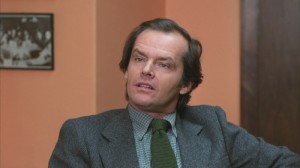
- “Hi, I’m Jack. I’m totally not crazy.”
The Shining opens with a series of glorious shots of a yellow VW bug driving up a mountain road. The mountains are large, the VW is small.
The car, we will soon learn, belongs to Jack Torrance, who’s driving up to the Overlook to interview for the chopping up his family caretaker job.
Why doesn’t the movie open with a scene of Jack, in the car, listening to the radio as he winds his way up the road? Halloran gets shots like that later, while he’s driving his snow-cat up those same roads through the snow.
The difference between Jack driving up in the fall and Halloran driving up in the winter is: Kubrick wants us to identify with Halloran, and he wants Jack to get lost in the landscape. The landscape overwhelms the yellow VW, even swallows it up at one point as he drives through a tunnel. Because the VW is the first relatable thing we see in the movie, the viewer identifies with it and shares its sense of being a tiny thing in a vast, forbidding landscape.
The Shining part 1
The Shining, when it came out in 1980, was roundly derided by critics and fans of the novel, to say nothing of the novelist, for being criminally, bone-headedly wrong. Why were people so upset?
Some were upset because of Jack Nicholson’s performance, which took the character from the novel and blew it up into a drooling, wild-eyed crazy man. Some people were upset because of the radical changes in the plot. Some were upset because they felt the movie didn’t take its subject matter seriously enough. Some were upset because they felt the movie was too “cold,” without emotion or heart.
I think the real reason people were upset was because they had trouble identifying the protagonist.
Who is the protagonist of The Shining? Let’s go down the list.
some thoughts on The Social Network
The Social Network is as good as everyone says it is.
When the first reviews appeared, I was baffled and a little concerned. I’m a big fan of David Fincher’s work, but the first three reviews I read compared the movie, favorably, to, in this order, Rashomon, The Godfather, and Citizen Kane.
Which, you will admit, is a pretty high set of bars to clear.
Now then, as it happens, The Social Network does, indeed, compare favorably to Rashomon, The Godfather and Citizen Kane, but probably not in the ways you think.
Like Rashomon, it succeeds in telling, and telling well, a story from three different points of view. And those three points of view are presented fairly, evenly and without rancor or bias. As in any well-presented drama, no one is wrong and no one is right — there are only characters whose desires conflict.
Like The Godfather and Citizen Kane, it is a drama about power and wealth in America, and the effect it has on people caught up in it. Like The Godfather, its style is restrained, classic and understated — there is very little of Fincher’s bravura technique on display. Like the Coen Brothers, Fincher is developing into a handsomely understated director who no longer feels the need to draw attention to his camera placement and editing tricks. Which is another way of saying that, stylistically, it’s not very much like Citizen Kane, so if you’re expecting a mind-blowing visual experience full of startling perspectives, jarring juxtapositions and fancy photographic effects, you may be disappointed.
(That said, there are some stunning visual effects that do absolutely nothing to call attention to themselves.)
Like The Godfather, it is a penetrating drama that reveals something of a secret history, a force that affects everyone but no one really knows anything about. The lives of geeks and the lives of gangsters couldn’t be more different, but The Social Network finds the common ground between both. The key line in The Godfather Part II is “We’re bigger than US Steel,” and part of the drama of The Social Network is revealing the lives of the people who are having such an impact on our present society.
Which brings me to the complaints that I’ve read online about the movie. (Ha! I said “I’ve read online” as though I receive information from any other source.) The people who don’t like the movie seem to fall into two related camps: there are people who feel that the movie “gets it wrong,” that that’s simply not what happened, and people who feel that the movie is invalid because it’s “old media” criticizing “new media,” presenting America’s online society as a bunch of shallow, idiotic twerps (and, by extension, the audiences of an intelligently-made movie as sophisticated, discerning and mature). To the first, I say “Who cares?” but to the second I say “What the hell are you talking about?” Because the movie simply doesn’t do any of those things. Rather, it presents, like The Godfather, and like Mad Men for that matter, a handful of individuals caught at a moment in history, reacting to and trying to keep up with a society that is going to either make them or destroy them as they try, in vain, to control the change they begin.
Nota bene
Thank you, loyal readers, for asking for analysis of the new season of The Venture Bros.
The show continues to be wonderful, complex, dark and funny. Unfortunately, my work as a screenwriter has overwhelmed me. My apologies.
My two cents on Scott Pilgrim
I know, the last thing anyone needs now is more internet commentary on Scott Pilgrim. But I’ve been reading all sorts of posts from people who are miserable, bitter or hopping mad about the movie’s failure at the box office. I’ve read about how the failure of Scott Pilgrim will cause Hollywood to bypass Comic-con, that it spells the death-knell for comics adaptations, that Hollywood will never take a chance again on interesting material, that it marks a turning point for the ongoing collapse of Hollywood filmmaking, that it will ruin careers and lead to an endless series of sequels and derivative crap on our multiplex screens.
Here’s my take: the movie is great. It’s fresh, unique, surprising, heartfelt and unexpectedly complex. Everybody connected to the project did a terrific job, including the studio, who stood behind a challenging piece of material and gave the filmmakers a long leash to create a heretofore unseen vision of life.
It disappointed at the box office, yes. And we could talk about why that happened. My own theory is that it’s a movie too difficult to sum up in an image or a trailer. It’s a comedy, a romance and an action movie all at the same time. Perhaps American audiences are stupid, but whenever the viewer’s response to a trailer or a poster is “What is it?” the movie is in trouble commercially.
A few days ago, I was watching Fight Club, another hard-to-define movie that captured a point in time, and was reminded that it, too, failed at the box office when it came out. And the same bitter accusations and blames were thrown about: never again will a studio take a chance on fresh material, American film will collapse, careers will end, etc.
And yet, eleven years later, Brad Pitt and Ed Norton are still movie stars with great taste in scripts, Fox is still in business, and David Fincher is still one of our most interesting and sought-after directors, and pretty much everyone recognizes Fight Club as a generation-defining classic.
I predict the same thing will happen here: Universal will survive, Edgar Wright and Michael Cera will have successful and lucrative careers, Bryan Lee O’Malley will become more popular than ever, and, every now and then, studios will take a chance on movies that step outside the rules of the marketplace.
Query
I went to Disneyland yesterday with my son Sam (9). We were waiting in line at the Indiana Jones ride, and, if you haven’t ridden it, one of the things they have in the waiting area is a dimly-heard radio program about the Temple of the Forbidden Eye, or whatever the thing is called that you’re about to walk into. In between broadcasts of the pretend news-show, they play Benny Goodman Glenn Miller (see below).
When “In the Mood” came on, Sam asked “What is this?” looking like someone had poured coffee into his Orangina. I said: “This is Benny Goodman Glenn Miller, this is a song that was really popular when Indiana Jones was doing the things he was doing. So they’ve got this pretend radio broadcast with this kind of music to get you ‘in the mood’ for the ride.”
Sam: “But Indiana Jones wouldn’t listen to stuff like this.”
And then it occurred to me: What would Indiana Jones listen to? I tried to picture him listening to any of the contemporary popular music of the day and drew a blank. I tried to picture him listening to classical music, but again nothing. I could imagine his father, Henry Jones Sr, listening to Bach and chiding young Indiana for not appreciating its precision and beauty, but as far as what Indiana Jones would listen to while grading papers or driving from place to place, nothing came to me.
So I turn to you, dear readers. I know there are Indiana Jones comics and novels and role-playing games and God knows what else — is there ever a mention of what Indy listens to?
(He sits through Willie Scott’s Cole Porter number in Temple of Doom, but he’s not there to listen to music, he’s there to deal with the nightclub’s owner, the vile Mr. Lau.)
The Good Machine No Budget Commandments
Folks often ask me “How do I get work in this crazy business? How do I get a manager/agent/production deal?”
Let me tell you, folks — everything is changing. Various forces — the economy, escalating production costs, union situations, studio re-structuring, etc — has created a Hollywood that is risk-averse in the extreme. Getting a movie made — by anyone — is harder than ever. There are fewer people at the top paying people anything at all to write movies. Ten years ago, one could sell a screenplay idea with a ten-minute pitch and a charming demeanor. These days, it’s common — utterly common — for producers to demand full scripts from writers competing for a studio job, for free, then decide which of the written-for-free scripts they will submit to the studio, then find out that the studio isn’t really interested in the material.
My advice for those wishing to become known as writers, especially writer-directors, is to produce your own work. It has never been easier to do — you can get an excellent camera for $1000 or less, you can get Final Cut Pro for the same amount (or less, if you’re a student). Then all you need is a script to shoot and you’re all set to go.
There are wonderful books out there that can teach you how to make a movie for nothing (Robert Rodriguez’s Rebel Without a Crew is my favorite) but now the nice people at Good Machine have put everything you need to know in a one-page easy-to-read list.
Users will note that this list, if followed strictly, will tend to produce intimate domestic dramas about people talking about feelings — mumblecore movies. That’s where imagination comes in. The fellow who wrote and directed Paranormal Activity followed all these rules to the letter — shot the movie in his own house, with a cast of less than a dozen, and with minimal props that could be found anywhere. What he brought to the format was a great idea that used the no-budget aspect of the production to its advantage — in fact, it pointed to it — in order to help sell its premise. The result, while domestic, is sufficiently scary enough to make $100 million and establish its creator as a major Hollywood talent.
